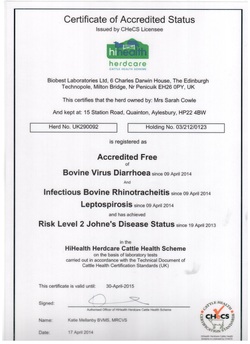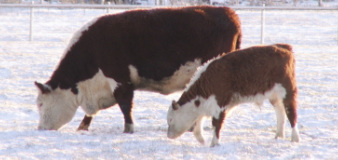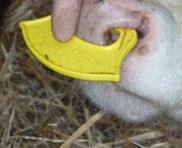High Hedges Hereford Cattle and Wiltshire Horn Sheep
Our Herefords
Accredited Status

The HighHedges herd has attained accredited status as free of BVD, IBR, Lepto and attained Risk Level 2 for Johnes Disease. We vaccinate for BVD only as our herd was discovered to be naïve on testing. All calves have been ear tissue tested since the autumn calves of 2012.
We have never had a problem with these diseases and started testing so that we knew the status of our herd for these four main diseases.
Animals bought in to the herd are all isolated for the required period and tested clear before being released into the herd.
We now envisage running a closed herd of females, only buying in bulls as required.
Purchasers of our stock can be assured that they are buying from a clean herd.
We have never had a problem with these diseases and started testing so that we knew the status of our herd for these four main diseases.
Animals bought in to the herd are all isolated for the required period and tested clear before being released into the herd.
We now envisage running a closed herd of females, only buying in bulls as required.
Purchasers of our stock can be assured that they are buying from a clean herd.
Management Regime

Our aim is to give our cattle as natural a life as possible. We appreciate the importance of the social structure in the herd and aim to give our cattle the space to sort themselves out safely.
Having said that, they are all halter trained and handled regularly, so that interventions for worming, pregnancy testing etc are as stress-free as possible. They all enjoy a groom, particularly when coat shedding. We can mingle with the herd inside and out without them being alarmed. A critical time is always when a heifer or cow calves, and being able to be a close observer without upsetting the mother is when this familarity pays off.
Our ground here is clay so is prone to becoming very wet in winter. If the ground allowed, we would keep everything out all year round, just feeding additional forage and vitamin/mineral licks and judging stock condition by eye and then with occasional weight checks.
The cost of concentrates seems to be ever rising, so having a breed that is hardy and yet still delivers is increasingly important. Lowergrove Blossom 2nd is a really good example of this and still does her calf well. She is here in the snow in November 2010 with her calf who is less than 2 months old.
Having said that, they are all halter trained and handled regularly, so that interventions for worming, pregnancy testing etc are as stress-free as possible. They all enjoy a groom, particularly when coat shedding. We can mingle with the herd inside and out without them being alarmed. A critical time is always when a heifer or cow calves, and being able to be a close observer without upsetting the mother is when this familarity pays off.
Our ground here is clay so is prone to becoming very wet in winter. If the ground allowed, we would keep everything out all year round, just feeding additional forage and vitamin/mineral licks and judging stock condition by eye and then with occasional weight checks.
The cost of concentrates seems to be ever rising, so having a breed that is hardy and yet still delivers is increasingly important. Lowergrove Blossom 2nd is a really good example of this and still does her calf well. She is here in the snow in November 2010 with her calf who is less than 2 months old.
Weaning

After our first weaning experience, we decided there must be a better way and we now practice a two-step weaning process. This involves putting a nose flap into the calf's nostrils at weaning time. The flap enables the calf to stay with its mother for longer but stops the calf suckling. The cow is less stressed as she has her calf with her, and it gets her used to not being suckled. The calf still has its mother around for security and it gets used to not suckling. The flap stays in the calf's nose for between 4 and 7 days. The second stage is then to remove the nose flap from the calf and separate the calf from the cow.The result is less stress for both, manifested by much less noise, much less marching and more time spent doing what cattle normally do - eat and lay down.
It is good to see that a scientific study at Writtle College (referenced on the Beef Site) has verified what we have observed in practice:
Stevens H, Blackie N and Amory JR: “The effect of a two-step weaning method on the behaviour of six-month old Belgian Blue cross-bred beef calves.”
It is good to see that a scientific study at Writtle College (referenced on the Beef Site) has verified what we have observed in practice:
Stevens H, Blackie N and Amory JR: “The effect of a two-step weaning method on the behaviour of six-month old Belgian Blue cross-bred beef calves.”
Highhedges herd history
Our first cattle were bought in 2010 from Lowergrove Herefords, a pair of in-calf females and a weaned steer destined for beef boxes. The females were both out of Mara Blossom U12 - a good milky cow and a consistent, regular breeder.
In 2011, Mara Diadem 26th joined us, followed by two more cow families in Bonny (from the Mara) and Curly from Badlingham.
In 2011, Mara Diadem 26th joined us, followed by two more cow families in Bonny (from the Mara) and Curly from Badlingham.
